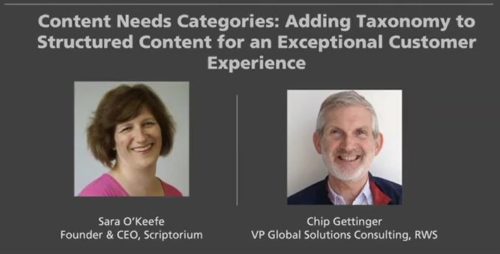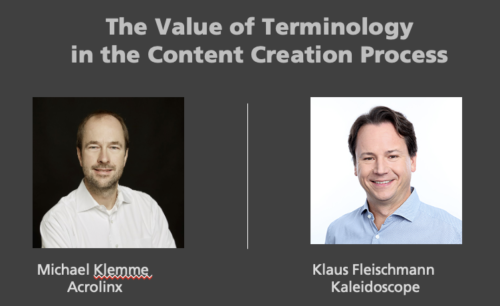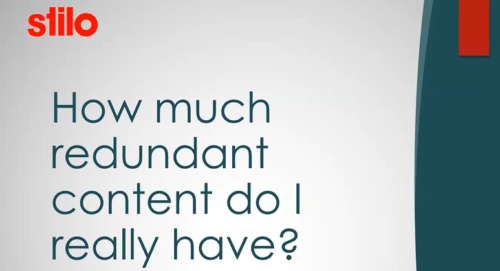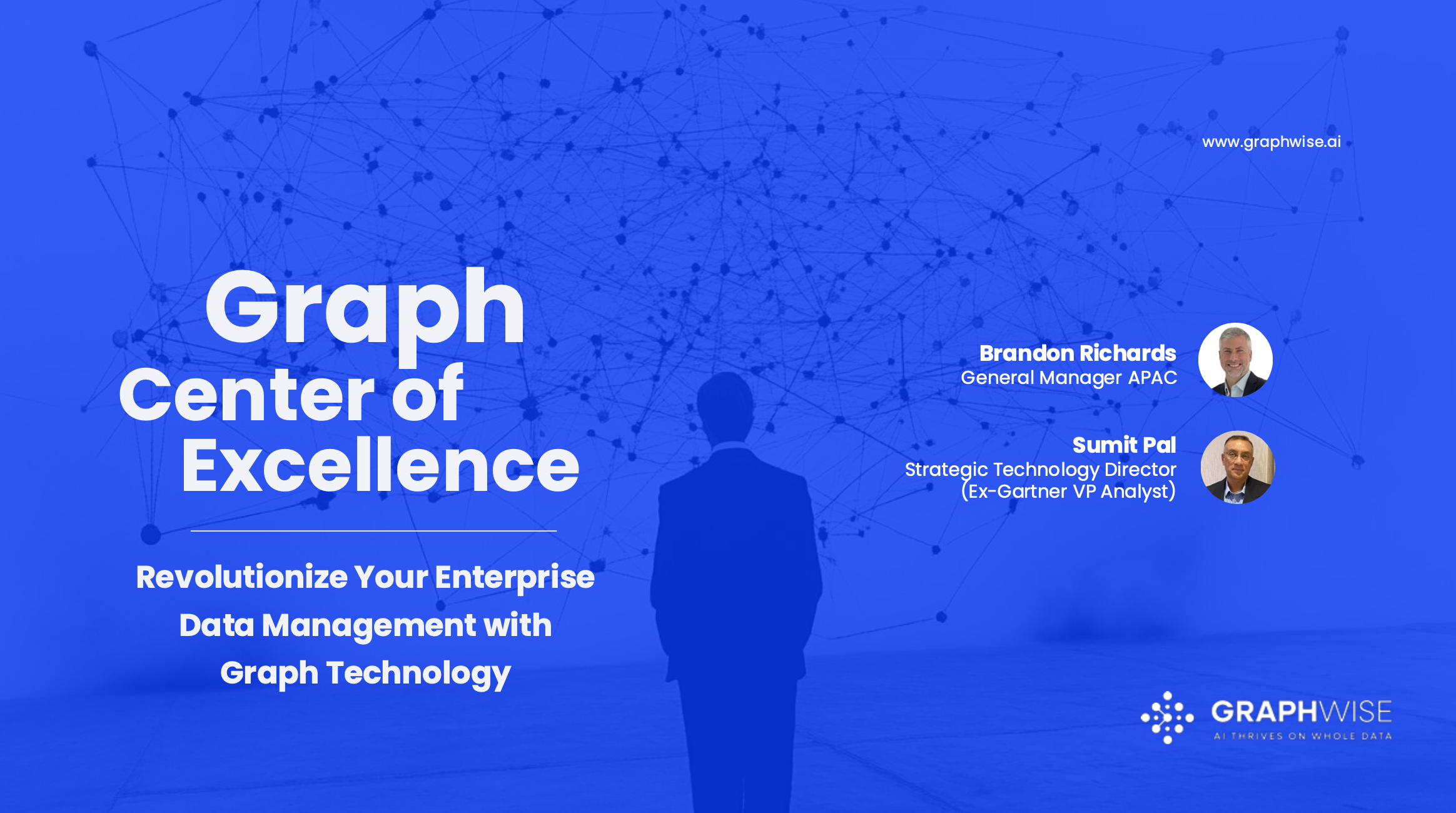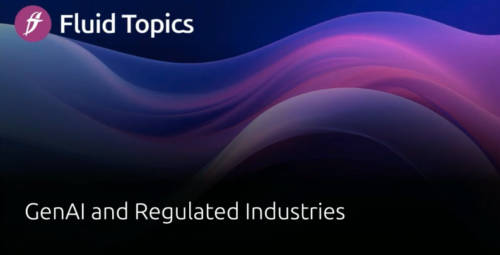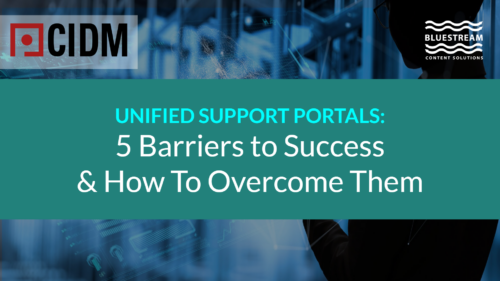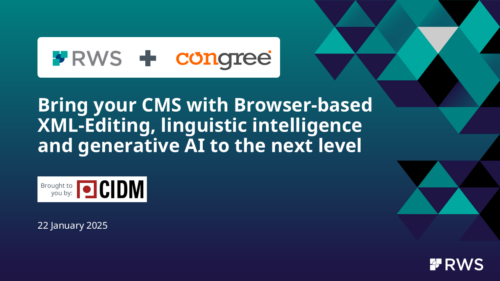-
Recorded: February 23, 2022 Structured content provides numerous benefits for organizations with authoring, managing, and delivering information. Perhaps your organization has realized these benefits—but what’s next? A formal content classification system, or a taxonomy, provides a framework that supports search, filtering, classification, consistent terminology, and more. The combination of taxonomy and structured content opens up compelling possibilities for digital delivery. Add continuous updates and advancements in business data, and you can transform the customer experience—but you may feel a little exposed out on the leading edge of technology. Sarah and Chip will present and discuss emerging trends, techniques, and technology for your digital information initiatives. During the webinar you’ll learn:
- How do you select and manage a good taxonomy?
- Classifying content – human, machine, or a combination?
- Coordinating taxonomy terms across various teams and languages
- Taking advantage of Semantic AI
- Business drivers examining tagging quality vs. quantity
- Best practices and actions for you
-
Recorded: April 13, 2022

 Presented by Michael Klemme and Klaus Fleischmann
Presented by Michael Klemme and Klaus Fleischmann
Terminology is at the core of great content. When used consistently, it helps you communicate precisely and efficiently, which is an approach to your brand communication. It also makes your content accurate.
But it’s important to have a sound process in place to manage your terminology. Join us and learn how to:
-
Make sure all stakeholders have input into your terminology set
-
Set a process for consent and approval of your terms
-
Make sure you have a consistent and failsafe process to
-
Have all your terms for checking in Acrolinx, as the content quality solution of choice
-
Make sure all terminology action is concentrated in quickTerm, as the leading terminology system
-
Michael Klemme is a Senior Solutions Architect at Acrolinx. He advises new and existing customers on how they can efficiently integrate Acrolinx into their processes and helps partners to develop integrations.
Klaus Fleischmann studied translation and IT in Vienna, holds an MA in Conference Interpreting from Monterey, California, and a MAS in Technical Communication from Krems, Austria. In 1996, he founded Austria-based Kaleidoscope, a company implementing content, translation, and terminology management processes for internationally active companies. Kaleidoscope develops online collaboration software for enterprise-level terminology workflow, translator query management, in-country review etc., making the translation quality process comprehensible and strategically manageable. In 2007, he became CEO of Austria´s leading LSP, Eurocom Translation Services GmbH. Always active in the industry, Klaus got voted into the Gala Board of Directors in 2015 and 2017. -
-
April 6, 2022 Content reuse is one of the many advantages of moving to DITA and a structured standard. It helps us reduce the amount of overall content we have, improve consistency, and decrease redundancy. However, it is difficult to visualize this value before the conversion takes place. Estimates can be off, and it is hardly ever clear how much content we can actually reuse from our documentation. Typos and partial matches only complicate our futile estimates. Narrowing the scope of this approximation by investigating similar matches in our source content before conversion can provide valuable insight to the potential benefits of moving to a structured standard. Join TJ Dhaliwal in this session as he uses Stilo’s Analyzer and Migrate to investigate source content for similar and exact matches. Then, further use that information to plan for conrefs, keyrefs, and topicrefs before any transformation takes place. Conclude by deduplicating exact topic matches and realizing some of the potential that was uncovered in the beginning. Presented by: TJ Dhaliwal is a Technical Sales Product Specialist at Stilo, helping customers uncover solutions to their content conversion needs. With a strong technical background in engineering combined with a passion for public speaking, he’s been able to successfully bridge the gaps between project stakeholders. As a problem solver, TJ has helped several enterprise-level companies convert tens of thousands of pages of their content to DITA. He’s recently taken lead on and helped bring to market Stilo’s newest product, Analyzer.
-
January 12, 2022 Moving to structured authoring and implementing a CMS are critical projects that will generate long-term efficiency gains and significant savings. But before you get there, there are great hurdles to overcome. First and foremost, there's winning budget approval from your execs, who will have a singular focus on risk and ROI. Second, you need to maintain a high level of commitment and buy-in from those executives over the years that re-engineering of content production can last. Too many content restructuring projects fail or don’t even start because they cannot demonstrate a quick and tangible return on investment - and this is where Dynamic Content Delivery changes the game. Dynamic Content Delivery provides outstanding content experiences to your users and creates immediate value for your company without requiring a big bang in your writing process. It earns you internal support, money, and time you can leverage to optimize your content restructuring process. In this webinar, you will learn:
- How Dynamic Content Delivery generates value from your existing content, no matter the writing tools and methods you are using now
- How to achieve quick wins and build a fast ROI to gain support from your Execs for your content project
- How to optimize your project to move to structured authoring and make it a success
-
February 15, 2022 Just putting your technical documentation on your webpage as a PDF for download will not make you a content hero. PDF is a given – a fundamental requirement. However, both business leaders and end customers expect more than just a documentation portal or a well-designed PDF. They want contextually relevant, personalized, consistent, conversational, and scalable content experiences. But how to deliver on this expectation? In this session, Stefan Gentz, Senior Worldwide Evangelist for Technical Communication at Adobe, will share some insights from the recent Adobe-commissioned Forrester study. Forrester surveyed 450 decision-makers on Content Experience Management to understand how global brands deliver relevant and contextual experiences across touchpoints. He will explore the design of positive customer journeys from marketing to technical support and self-service and back to sales – experiences that provide 360° content experience for your customers and handhold them across their whole content journey. Presented by: Stefan’s mission is to inspire enterprises and technical writers around the world and show how to create compelling technical communication content with the Adobe Technical Communication tools. He is also a certified Quality Management Professional (TÜV), ISO 9001 / EN 15038 auditor, ISO 31000 Risk Management expert, and Six Sigma Champion. As a sought-after keynote speaker and moderator at conferences around the world, he travels around the globe half of the year. Besides that, he has been the European Ambassador for the Globalization and Localization Association (GALA) for many years, a member of the tekom Conference Advisory Board for several years, and is now a member of the tekom iiRDS working group for Intelligent Information and member of the OASIS DITA Adoption Committee. In 2016, Stefan Gentz was awarded by MindTouch as one of the Top 25 Leading Content Strategist Influencers in the world and as one of the Top 25 Content Experience Influencers in the world in 2017. Stefan Gentz on LinkedIn Stefan Gentz on XING @stefangentz on Twitter www.adobe.com
-
June 18, 2025 9:00 am – 10:30 am PDT | 12:00 pm – 1:30 pm EDT | 5:00 pm – 6:30 pm BST
 Presented by Fabrice Lacroix and Frank MillerStructured content is finally getting its moment. Long under appreciated outside the inner circle of tech comm professionals, it is now stepping in the spotlight. As a sine qua non for effective AI, structured content is driving a massive and urgent interest at the highest levels of organizations.This unprecedented opportunity comes with a major shift in adoption strategy enabled by Content Delivery Platforms (CDPs). Going “delivery-first” rather than “structure-first” delivers early, visible outcomes across the enterprise, and paves the way for faster, broader adoption.Join us for an insightful webinar with Frank Miller, thought leader in the information development industry and CEO of Ryffine, and Fabrice Lacroix, AI and search technology pioneer and CEO of Fluid Topics, as they share actionable strategies to:- Turn the momentum of AI into enterprise buy-in for structured content initiatives- Leverage your existing content with modern content delivery for early results across the company- Navigate a more flexible, incremental adoption path of structured content with growing benefits along the way
Presented by Fabrice Lacroix and Frank MillerStructured content is finally getting its moment. Long under appreciated outside the inner circle of tech comm professionals, it is now stepping in the spotlight. As a sine qua non for effective AI, structured content is driving a massive and urgent interest at the highest levels of organizations.This unprecedented opportunity comes with a major shift in adoption strategy enabled by Content Delivery Platforms (CDPs). Going “delivery-first” rather than “structure-first” delivers early, visible outcomes across the enterprise, and paves the way for faster, broader adoption.Join us for an insightful webinar with Frank Miller, thought leader in the information development industry and CEO of Ryffine, and Fabrice Lacroix, AI and search technology pioneer and CEO of Fluid Topics, as they share actionable strategies to:- Turn the momentum of AI into enterprise buy-in for structured content initiatives- Leverage your existing content with modern content delivery for early results across the company- Navigate a more flexible, incremental adoption path of structured content with growing benefits along the way Fabrice Lacroix is a serial entrepreneur and a technology pioneer. He has been working for 25 years on the development of innovative solutions around search technology, content enrichment and AI. He is the founder of Fluid Topics, the leading Content Delivery Platform that reinvents how users search, read and interact with technical documentation.
Fabrice Lacroix is a serial entrepreneur and a technology pioneer. He has been working for 25 years on the development of innovative solutions around search technology, content enrichment and AI. He is the founder of Fluid Topics, the leading Content Delivery Platform that reinvents how users search, read and interact with technical documentation. For nearly 20 years, Frank Miller has been in the trenches of structured content implementations. As founder of Ryffine, he's guided teams across virtually every industry—from manufacturing to healthcare to software—through the challenges of making structured content work in the real world.
Frank has collaborated with documentation teams of all sizes and worked alongside most major technology vendors in the structured content space. He's particularly drawn to technical documentation as an undervalued discipline, finding satisfaction in championing the business critical work that rarely gets the recognition it deserves.
For nearly 20 years, Frank Miller has been in the trenches of structured content implementations. As founder of Ryffine, he's guided teams across virtually every industry—from manufacturing to healthcare to software—through the challenges of making structured content work in the real world.
Frank has collaborated with documentation teams of all sizes and worked alongside most major technology vendors in the structured content space. He's particularly drawn to technical documentation as an undervalued discipline, finding satisfaction in championing the business critical work that rarely gets the recognition it deserves.
-
Recorded on May 21, 2025
 Presented by: Ursula Reuther, Congree
Presented by: Ursula Reuther, Congree
Ursula Reuther is Chief Linguistic Consultant at Congree Language Technologies GmbH and head of the linguistic department at Congree.
Ursula graduated with a degree in Applied Linguistics and Translation Sciences. She has over 35 years of experience in the field of language technology and engineering, in 2011 she joined Congree. Her main interests focus on language standardization, Controlled Language, and terminology.
-
Recorded on May 7, 2025
 As we stand on the brink of the AI revolution, many organizations find themselves entangled in the complexities of disparate, isolated data systems. Challenges like data governance, trust issues, and poor data quality are just a few of the hurdles stalling the progress of enterprise AI initiatives.
Enter graph technologies—your essential ally in crafting data-driven strategies for the AI era. These innovative approaches streamline and elevate data management, offering substantial cost reductions while significantly enhancing your ability to derive valuable insights and integrate them seamlessly into your business operations.
This session underscores the imperative for organizations to develop robust graph technology capabilities, simplifying and refining data integration and governance across fragmented data landscapes. Discover how these cutting-edge technologies unlock a spectrum of enhanced data outcomes, paving the way for groundbreaking advancements in data analytics and automation that were once out of reach.
Join us to delve into the strategic adoption of graph technologies within your enterprise. We'll guide you through establishing a Graph Center of Excellence (CoE), emphasizing its critical role, practical applications, starting points, governance needs, and best practices for a triumphant implementation. You'll uncover the foundational elements of the Graph CoE, including:
As we stand on the brink of the AI revolution, many organizations find themselves entangled in the complexities of disparate, isolated data systems. Challenges like data governance, trust issues, and poor data quality are just a few of the hurdles stalling the progress of enterprise AI initiatives.
Enter graph technologies—your essential ally in crafting data-driven strategies for the AI era. These innovative approaches streamline and elevate data management, offering substantial cost reductions while significantly enhancing your ability to derive valuable insights and integrate them seamlessly into your business operations.
This session underscores the imperative for organizations to develop robust graph technology capabilities, simplifying and refining data integration and governance across fragmented data landscapes. Discover how these cutting-edge technologies unlock a spectrum of enhanced data outcomes, paving the way for groundbreaking advancements in data analytics and automation that were once out of reach.
Join us to delve into the strategic adoption of graph technologies within your enterprise. We'll guide you through establishing a Graph Center of Excellence (CoE), emphasizing its critical role, practical applications, starting points, governance needs, and best practices for a triumphant implementation. You'll uncover the foundational elements of the Graph CoE, including:
- Key Elements of the Graph CoE
- Strategic Graph Deployment
- Real Life Use Cases
- Why Organizations Need to Change Their Data Management Paradigm
- The “Bad Data Tax” Organizations are repeatedly paying with low payoff
- The Solution to the Data Dilemma
 Sumit has more than 30 years of experience in the data and Software Industry in various roles spanning companies from startups to enterprise organizations in building, managing and guiding teams and building scalable software systems across the stack from middle tier, data layer, analytics and UI using Big Data, NoSQL, DB Internals, Data Warehousing, Data Modeling, Data Science and middle tier.
Sumit has more than 30 years of experience in the data and Software Industry in various roles spanning companies from startups to enterprise organizations in building, managing and guiding teams and building scalable software systems across the stack from middle tier, data layer, analytics and UI using Big Data, NoSQL, DB Internals, Data Warehousing, Data Modeling, Data Science and middle tier. Brandon has spent the last 8 years helping hundreds of enterprises across APAC on their graph technology journey at both Graphwise (Ontotext) and Neo4j. During that time, he has focused on shifting the “graph” conversations to C-level and senior executives for a more strategic approach to their digital transformations. Prior to that, he spent 6 years at Oracle working with strategic accounts and founded and managed a commercial real estate strategy firm in Silicon Valley for over 4 years. Brandon is currently based in Kuala Lumpur, Malaysia.As our ambassadors of the Graph Center of Excellence, Sumit and Brandon are excited to spread the good word of graph to the CIDM community.
Brandon has spent the last 8 years helping hundreds of enterprises across APAC on their graph technology journey at both Graphwise (Ontotext) and Neo4j. During that time, he has focused on shifting the “graph” conversations to C-level and senior executives for a more strategic approach to their digital transformations. Prior to that, he spent 6 years at Oracle working with strategic accounts and founded and managed a commercial real estate strategy firm in Silicon Valley for over 4 years. Brandon is currently based in Kuala Lumpur, Malaysia.As our ambassadors of the Graph Center of Excellence, Sumit and Brandon are excited to spread the good word of graph to the CIDM community. -
Recorded on April 23, 2025
 Can regulated industries afford to miss the GenAI wave because of its potential risks? Regardless of the use case – from employee productivity to user information – the technology will need to be closely controlled and monitored. Tracing and auditing user interactions as well as LLM replies and measuring any drift in quality and reliability are absolute necessities. In this session, we will examine the risks of GenAI in Content Delivery, from security and compliance to misinformation and liability, and will discuss what it takes to mitigate them and safely integrate GenAI into highly regulated sectors.
Presented by Fabrice Lacroix
Can regulated industries afford to miss the GenAI wave because of its potential risks? Regardless of the use case – from employee productivity to user information – the technology will need to be closely controlled and monitored. Tracing and auditing user interactions as well as LLM replies and measuring any drift in quality and reliability are absolute necessities. In this session, we will examine the risks of GenAI in Content Delivery, from security and compliance to misinformation and liability, and will discuss what it takes to mitigate them and safely integrate GenAI into highly regulated sectors.
Presented by Fabrice Lacroix
 Fabrice Lacroix is a serial entrepreneur and a technology pioneer. He has been working for 25 years on the development of innovative solutions around search technology, content enrichment and AI. He is the founder of Fluid Topics, the leading Content Delivery Platform that reinvents how users search, read and interact with technical documentation.
Fabrice Lacroix is a serial entrepreneur and a technology pioneer. He has been working for 25 years on the development of innovative solutions around search technology, content enrichment and AI. He is the founder of Fluid Topics, the leading Content Delivery Platform that reinvents how users search, read and interact with technical documentation. -
Recorded on February 20, 2025
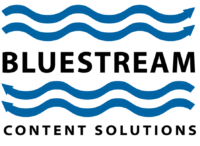 Organizations often struggle with deploying unified portals for their technical support documentation due to a variety of challenges. These challenges can stem from a lack of resources, insufficient understanding of user needs, and difficulties in creating and maintaining comprehensive documentation. This webinar will explore the reasons behind the hesitance to implement unified portals and suggest successful approaches to overcome these obstacles.Presented by Andrew Douglas
Organizations often struggle with deploying unified portals for their technical support documentation due to a variety of challenges. These challenges can stem from a lack of resources, insufficient understanding of user needs, and difficulties in creating and maintaining comprehensive documentation. This webinar will explore the reasons behind the hesitance to implement unified portals and suggest successful approaches to overcome these obstacles.Presented by Andrew Douglas Andrew Douglas, Business Development Manager @BlueStream 25 years in SaaS based Consultative Software Sales. Consultative/Solution Selling approach to position value driven Enterprise class CCMS and Publishing platform. andrewd@bluestream.com
Andrew Douglas, Business Development Manager @BlueStream 25 years in SaaS based Consultative Software Sales. Consultative/Solution Selling approach to position value driven Enterprise class CCMS and Publishing platform. andrewd@bluestream.com -
Recorded on February 26, 2025
 Join us for an insightful webinar showcasing how content can be seamlessly generated from existing data sources rather than manually crafted, ensuring accuracy, consistency, and efficiency.This session will explore real-world examples from AMD and Fluid Topics, illustrating how automated processes turn technical data into professional, readable documentation at scale.We'll demonstrate:- Automated Register Documentation: See how CPU specifications transform into organized, structured documentation, stored in a database, then delivered as HTML straight to the documentation portal.- Hands-Free API Doc Conversion: Discover how API information is converted to DITA and integrated into CCMS to enrich comprehensive technical guides and manuals.- Instant Release Notes Generation: Learn how JIRA-based data automatically generates release notes in sync with new versions, ensuring timely updates without human intervention.Presented by Fabrice Lacroix and Doug Brook
Join us for an insightful webinar showcasing how content can be seamlessly generated from existing data sources rather than manually crafted, ensuring accuracy, consistency, and efficiency.This session will explore real-world examples from AMD and Fluid Topics, illustrating how automated processes turn technical data into professional, readable documentation at scale.We'll demonstrate:- Automated Register Documentation: See how CPU specifications transform into organized, structured documentation, stored in a database, then delivered as HTML straight to the documentation portal.- Hands-Free API Doc Conversion: Discover how API information is converted to DITA and integrated into CCMS to enrich comprehensive technical guides and manuals.- Instant Release Notes Generation: Learn how JIRA-based data automatically generates release notes in sync with new versions, ensuring timely updates without human intervention.Presented by Fabrice Lacroix and Doug Brook Fabrice Lacroix is a serial entrepreneur and a technology pioneer. He has been working for 25 years on the development of innovative solutions around search technology, content enrichment and AI. He is the founder of Fluid Topics, the leading Content Delivery Platform that reinvents how users search, read and interact with technical documentation.
Fabrice Lacroix is a serial entrepreneur and a technology pioneer. He has been working for 25 years on the development of innovative solutions around search technology, content enrichment and AI. He is the founder of Fluid Topics, the leading Content Delivery Platform that reinvents how users search, read and interact with technical documentation. Doug Brook is the Director of Technical Documentation and Localization for adaptive computing at Advanced Micro Devices, Inc. (AMD). Throughout 20+ years in senior management of technical content organizations, he has led evolutions of information resources to improve user experience for numerous high-tech companies, large and small. A past Society for Technical Communication (STC) panelist, he holds undergraduate and graduate degrees from Carnegie Mellon University. He has successfully navigated technical documentation teams through several corporate acquisitions and has introduced new authoring systems and content delivery platforms multiple times. As an experienced technical writer, educator, and theatre artist, he leverages a broad perspective of how to effectively serve diverse audience types and how to optimize processes for people to more effectively serve them.
Doug Brook is the Director of Technical Documentation and Localization for adaptive computing at Advanced Micro Devices, Inc. (AMD). Throughout 20+ years in senior management of technical content organizations, he has led evolutions of information resources to improve user experience for numerous high-tech companies, large and small. A past Society for Technical Communication (STC) panelist, he holds undergraduate and graduate degrees from Carnegie Mellon University. He has successfully navigated technical documentation teams through several corporate acquisitions and has introduced new authoring systems and content delivery platforms multiple times. As an experienced technical writer, educator, and theatre artist, he leverages a broad perspective of how to effectively serve diverse audience types and how to optimize processes for people to more effectively serve them.
-
Recorded on January 22, 2025
 Subject Matter Experts (SME) play an ever-increasing role in your authoring processes. But they are not XML experts. Discover how you can enable them to create content that is consistent in terms of structure, language and terminology by modernizing and enhancing your (Component) Content Management with:
Subject Matter Experts (SME) play an ever-increasing role in your authoring processes. But they are not XML experts. Discover how you can enable them to create content that is consistent in terms of structure, language and terminology by modernizing and enhancing your (Component) Content Management with:- Browser-based authoring designed for users with no XML expertise
- Integrated linguistic intelligence to facilitate terminology design and usage, and GenAI for efficiency, consistency, and content reuse
- Collaborative features for seamless editing and review, taking the pain out of longwinded and error prone review cycles
Presented by:
 Torsten Machert, Congree
Torsten studied Russian and Spanish. After he graduated at the Humboldt University, Berlin, he spent more that 20 years in the CMS business and became an industry expert in SGML and XML based management and publication processes.
As Senior Consultant with Congree he can perfectly combine his linguistic and XML background.
Torsten Machert, Congree
Torsten studied Russian and Spanish. After he graduated at the Humboldt University, Berlin, he spent more that 20 years in the CMS business and became an industry expert in SGML and XML based management and publication processes.
As Senior Consultant with Congree he can perfectly combine his linguistic and XML background.
 André Schlotz, RWS
André Schlotz is VP Global Automotive and Manufacturing Solutions, RWS Group. He helps organizations to digitalize their content supply chain through structured content authoring, component content management and single source content delivery. Before joining RWS in 2013 he was holding various management positions in manufacturing companies in product development, aftersales, process organization and IT. He has more than 20 years of experiences in process consulting, planning, building and running digital industry solutions.
André Schlotz, RWS
André Schlotz is VP Global Automotive and Manufacturing Solutions, RWS Group. He helps organizations to digitalize their content supply chain through structured content authoring, component content management and single source content delivery. Before joining RWS in 2013 he was holding various management positions in manufacturing companies in product development, aftersales, process organization and IT. He has more than 20 years of experiences in process consulting, planning, building and running digital industry solutions.

